In the 1960s, Dr. Jack Geiger and a group of health professionals started a community health center in the Mississippi Delta, where children were dying from infectious diarrhea and malnutrition. Geiger and company began writing prescriptions for healthy food — patients would buy the prescribed food at a grocery store that would charge the clinic for the cost. When Geiger caught flack for prescribing food instead of drugs, he replied, “The last time I looked at my textbooks, the most specific therapy for malnutrition was food.”
Poor diet and poor health: A clear connection
Decades later, many Americans still struggle to access and eat healthy food. Despite the well-understood connection between diet and health and a clear understanding of the components of a healthy diet, approximately 90% of Americans eat less than the recommended amount of fruits and vegetables. Moreover, the typical American diet increasingly places meat at the center of the plate, and gets a majority of its calories from ultraprocessed foods — which, despite the widespread use of health-focused marketing, are usually less nutrient dense than whole foods. The result of this nutritionally deficient, empty-caloried glut is often disease. As the World Health Organization notes: “Unhealthy diet is one of the leading risks for the global burden of disease, mainly for noncommunicable diseases such as cardiovascular diseases, diabetes, and cancer.” It’s this understanding of diet at the basis of health that underpins the modern Food Is Medicine (FIM) movement, which works to insert nutrition as an intervention into hospitals and healthcare settings on both population and individual levels.
The crux of FIM is the provision of healthy food to treat diet-related diseases. As Ronit Ridberg, a research assistant professor at Tufts University’s Food Is Medicine Institute, explains, the critical link lies within healthcare. “It’s a referral from your primary care provider or another healthcare provider, and it’s really tied to a health condition that’s related to diet,” Ridberg says. FIM interventions entail the distribution or subsidizing of healthy food to patients, some of whom may not otherwise have access. While there are some overlaps with direct hunger- and access-based efforts, FIM is distinct in that it uses healthy food to treat health conditions specifically. The thinking behind FIM is “more about food and nutrition support being tied to the health system,” Ridberg adds.
There’s a place for the FIM movement in Western healthcare because little has changed since Geiger’s community health clinic days. Our medical system, driven by the pharmaceutical industry, is still anchored in medication as the answer. Even hospitals themselves fail to prioritize nutrition, offering junk food-filled meals to patients and lining their hallways with vending machines.
How a Food Is Medicine initiative works will vary from organization to organization and state to state. Some programs offer vouchers to buy produce at farmers markets or grocery stores while others offer individual heat-and-eat meals to help treat medical conditions from diabetes to hypertension, or to support health issues associated with pregnancy. Food Is Medicine efforts also often include nutrition-focused counseling and educational elements, especially the programs that focus on grocery provision. “In an ideal situation, you’re getting groceries plus some support and help around what to do with the groceries,” Ridberg says. “The most effective programs are the ones that have support or education alongside the food itself.”
A modern campaign with historic and traditional roots
While the contemporary FIM movement’s roots stretch back decades, it’s hardly a new concept. When the Reagan administration did little to recognize, much less address, the HIV/AIDS epidemic that was ravaging marginalized communities in the 1980s, community members organized to care for the sick themselves. Organizations across the country — from Boston’s Community Servings to San Francisco’s Open Hand — began providing nutritional support to those dying from the virus, thus marking the beginning of the modern FIM movement in the United States.
Of course, the understanding that food is medicine, that our health is centrally impacted by the food we eat, has been at the heart of traditional and Indigenous ways of knowing and being for millennia. Indeed, failing to acknowledge that connection is a form of erasure. As weight-inclusive public health dietitian Anjali Prasertong explains in her Substack newsletter, Antiracist Dietitian, “proclaiming ‘food isn’t medicine’ denies the reality of cultural traditions that have always viewed food as a source of healing, for thousands of years before medicine became synonymous with pharmaceuticals.”
Dana Thompson, co-founder of North American Traditional Indigenous Food Systems and founder of Heti, a social impact brand focused on health and wealth in Indigenous communities, explains further: “Only eating gas station food is obviously different than going out into the world and hunting and being with nature, collecting mushrooms and different things to process through natural means like sun drying and wind drying. All these different ways that Indigenous communities process foods is so much better for you.” In contrast to the ultraprocessed foods that saturate the U.S. food market — and which are linked to 32 health conditions from mental health disorders to heart disease — Indigenous traditions are focused on eating foods that are seasonal, whole and as close to their natural state as possible.
The modern Food Is Medicine movement is still a far cry from the Indigenous and traditional understandings that healthy food is critical for everyone — regardless of health condition. But “the reason this is a conversation to be had now is because we’re 150 years into this industrialized food system, and all of the inflammatory diseases [associated with] the onset of packaged foods and moving away from processing food with your community,” Thompson says.
Acknowledging food as cause and cure
Cate Hensley is the manager of policy and projects for the Food Is Medicine Coalition (FIMC), a national coalition of FIM providers that’s currently accrediting the movement’s nutrition standards. She ties the recent interest in FIM — from the White House’s 2022 Conference on Hunger, Nutrition, and Health to the Aspen Institute’s 2022 publishing of its first Food Is Medicine Research Action Plan, which it updated earlier this year — in part to a growing body of research.
Studies show that dietary patterns have been linked to a reduced risk of obesity and hypertension, that diet can both prevent and treat type 2 diabetes, and that it can help maintain cognitive and kidney function as well as a healthy gut microbiome. One study found that providing medically tailored meals to patients with diet-sensitive conditions, if implemented across the country, could help avert 1.6 million hospitalizations while offering insurers a net cost savings of $13.6 billion a year. Over the course of a decade, this could amount to spending $185.1 billion less on healthcare and averting almost 18.3 million hospitalizations.
“The COVID-19 pandemic was another big reckoning moment of how important the role of food and nutrition service providers are in our nation,” explains Hensley, speaking about those who became frontline workers. It “really led to that galvanizing moment in the White House Conference on Hunger, Nutrition, and Health, … [which] has led to this incredible renewed interest in providing quality nutrition on a truly broad-reaching scale across the country.” Federal efforts to ramp up the conversation continue today. Just two weeks ago, the Senate Health, Education, Labor and Pensions (HELP) Committee held a hearing titled: “What Is the FDA Doing to Reduce the Diabetes and Obesity Epidemics in America and Take on the Greed of the Food and Beverage Industry?”
Challenges remain
Still, Hensley is under no illusion that the broader systems surrounding the FIM movement are where they need to be. Doctors in the United States don’t get rigorous, evidence-based nutrition education as a part of their medical education. Plus, as Ridberg notes, so many healthcare providers are simply overburdened — they have a narrow window of time with patients as is, are already screening for issues like food insecurity, and generally struggle to make space for yet another intervention. At the same time, “any physicians or healthcare providers who I’ve heard speak or have interviewed … are so excited to have a real, tangible resource to give their patients” in the form of Food Is Medicine, she says. What a medically tailored meal program or a produce prescription service offers is the opportunity for physicians to provide an actionable solution to their patients rather than just advice to eat more fruits and vegetables; such advice falls flat without addressing the access and information barriers that stand in the way.
“We can’t close our eyes and pretend that the food system does not deeply, deeply impact our work in Food Is Medicine.”
CATE HENSLEY, manager of policy and projects, Food Is Medicine Coalition (FIMC)
Hensley adds that the FIMC also works to advocate for policy solutions that are designed to increase reimbursement for FIM services, which are “often spearheaded or funded by hospitals and health systems, government agencies, insurers and philanthropic entities,” according to the American Hospital Association. The FIMC aims to support its colleagues who are endeavoring to better nutrition policy and programs, from SNAP and WIC to school meals. “We’re cheering those folks on as loudly as we can, but with our mission and vision we’re really orienting our work around the healthcare piece,” she says. And that is, in some ways, where FIM faces challenges.
As the Food Is Medicine movement works toward universal coverage for its initiatives by insurance companies, there is an understanding that it probably won’t be enough. “Even if universal reimbursement is achieved tomorrow, there will always be a need for our agencies,” Hensley says. “Folks will always be uninsured or underinsured, undocumented — the list goes on.” And with insurance companies prioritizing profit above all else, there will still be a need for significant regulatory and industrial overhaul.
FIM remains necessary because our food system is often a source of disease, and our healthcare system focuses primarily on treatment rather than prevention — and those are the systems within which FIM operates. “We can’t close our eyes and pretend that the food system does not deeply, deeply impact our work in Food Is Medicine,” Hensley says. The need for FIM will persist so long as our current food and healthcare systems remain largely unchanged.




Shares